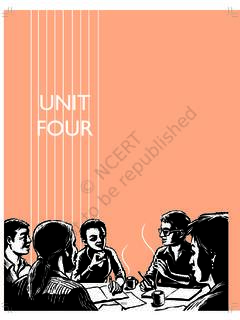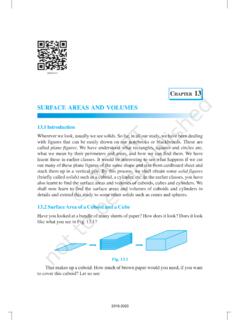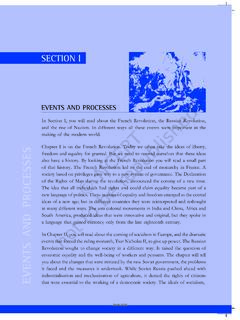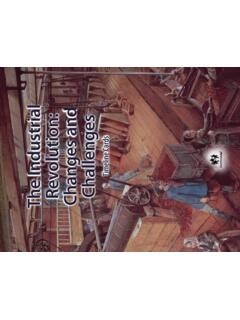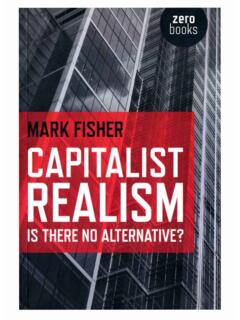Transcription of Socialism in Europe and the Russian Revolution Chapter II
1 Socialism in Europe and the Russian Revolution25 Socialism in Europe andSocialism in Europe andSocialism in Europe andSocialism in Europe andSocialism in Europe andthe Russian Revolutionthe Russian Revolutionthe Russian Revolutionthe Russian Revolutionthe Russian Revolution1 The Age of Social ChangeIn the previous Chapter you read about the powerful ideas of freedomand equality that circulated in Europe after the French French Revolution opened up the possibility of creating adramatic change in the way in which society was structured. As youhave read, before the eighteenth century society was broadly dividedinto estates and orders and it was the aristocracy and church whichcontrolled economic and social power. Suddenly, after the Revolution ,it seemed possible to change this. In many parts of the world includingEurope and Asia, new ideas about individual rights and whocontrolled social power began to be discussed.
2 In India, RajaRammohan Roy and Derozio talked of the significance of the FrenchRevolution, and many others debated the ideas of post-revolutionaryEurope. The developments in the colonies, in turn, reshaped theseideas of societal everyone in Europe , however, wanted a complete transformationof society. Responses varied from those who accepted that somechange was necessary but wished for a gradual shift, to those whowanted to restructure society radically. Some were conservatives ,others were liberals or radicals . What did these terms really meanin the context of the time? What separated these strands of politicsand what linked them together? We must remember that these termsdo not mean the same thing in all contexts or at all will look briefly at some of the important political traditions ofthe nineteenth century, and see how they influenced change.
3 Thenwe will focus on one historical event in which there was an attemptat a radical transformation of society. Through the Revolution inRussia, Socialism became one of the most significant and powerfulideas to shape society in the twentieth Liberals, Radicals and ConservativesOne of the groups which looked to change society were the wanted a nation which tolerated all religions. We shouldremember that at this time European states usually discriminated inSocialism in Europe and the Russian RevolutionChapter II2019-2020 India and the Contemporary World26favour of one religion or another (Britain favoured the Church ofEngland, Austria and Spain favoured the Catholic Church). Liberalsalso opposed the uncontrolled power of dynastic rulers. They wantedto safeguard the rights of individuals against governments.
4 Theyargued for a representative, elected parliamentary government, subjectto laws interpreted by a well-trained judiciary that was independentof rulers and officials. However, they were not democrats . Theydid not believe in universal adult franchise, that is, the right of everycitizen to vote. They felt men of property mainly should have thevote. They also did not want the vote for contrast, radicals wanted a nation in which government was basedon the majority of a country s population. Many supported women ssuffragette movements. Unlike liberals, they opposed the privilegesof great landowners and wealthy factory owners. They were notagainst the existence of private property but disliked concentrationof property in the hands of a were opposed to radicals and liberals.
5 After the FrenchRevolution, however, even conservatives had opened their minds tothe need for change. Earlier, in the eighteenth century, conservativeshad been generally opposed to the idea of change. By the nineteenthcentury, they accepted that some change was inevitable but believedthat the past had to be respected and change had to be brought aboutthrough a slow differing ideas about societal change clashed during the socialand political turmoil that followed the French Revolution . Thevarious attempts at Revolution and national transformation in thenineteenth century helped define both the limits and potential ofthese political Industrial Society and Social ChangeThese political trends were signs of a new time. It was a time ofprofound social and economic changes.
6 It was a time when new citiescame up and new industrialised regions developed, railways expandedand the Industrial Revolution brought men, women and children to factories. Workhours were often long and wages were poor. Unemployment wascommon, particularly during times of low demand for industrial and sanitation were problems since towns were growingrapidly. Liberals and radicals searched for solutions to these wordsSuffragette movement A movement togive women the right to in Europe and the Russian Revolution27 Almost all industries were the property of individuals. Liberals andradicals themselves were often property owners and made their wealth through trade or industrial ventures, theyfelt that such effort should be encouraged that its benefits wouldbe achieved if the workforce in the economy was healthy and citizenswere educated.
7 Opposed to the privileges the old aristocracy had bybirth, they firmly believed in the value of individual effort, labourand enterprise. If freedom of individuals was ensured, if the poorcould labour, and those with capital could operate without restraint,they believed that societies would develop. Many working men andwomen who wanted changes in the world rallied around liberal andradical groups and parties in the early nineteenth nationalists, liberals and radicals wanted revolutions to put anend to the kind of governments established in Europe in 1815. InFrance, Italy, Germany and Russia, they became revolutionaries andworked to overthrow existing monarchs. Nationalists talked ofrevolutions that would create nations where all citizens would The London poor in the mid-nineteenth century as seen by : Henry Mayhew, London Labour and the London Poor, and the Contemporary World28 Activityequal rights.
8 After 1815, Giuseppe Mazzini, an Italian nationalist, conspiredwith others to achieve this in Italy. Nationalists elsewhere including India read his The Coming of Socialism to EuropePerhaps one of the most far-reaching visions of how society should bestructured was Socialism . By the mid - nineteenth century in Europe , socialismwas a well-known body of ideas that attracted widespread were against private property, and saw it as the root of all social illsof the time. Why? Individuals owned the property that gave employmentbut the propertied were concerned only with personal gain and not withthe welfare of those who made the property productive. So if society as awhole rather than single individuals controlled property, more attentionwould be paid to collective social interests.
9 Socialists wanted this change andcampaigned for could a society without property operate? What would be the basis ofsocialist society?Socialists had different visions of the future. Some believed in the idea ofcooperatives. Robert Owen (1771-1858), a leading English manufacturer,sought to build a cooperative community called New Harmony in Indiana(USA). Other socialists felt that cooperatives could not be built on a widescale only through individual initiative: they demanded that governmentsencourage cooperatives. In France, for instance, Louis Blanc (1813-1882)wanted the government to encourage cooperatives and replace capitalistenterprises. These cooperatives were to be associations of people whoproduced goods together and divided the profits according to the workdone by Marx (1818-1883) and Friedrich Engels (1820-1895) added other ideasto this body of arguments.
10 Marx argued that industrial society was capitalist .Capitalists owned the capital invested in factories, and the profit of capitalistswas produced by workers. The conditions of workers could not improveas long as this profit was accumulated by private capitalists. Workers had tooverthrow capitalism and the rule of private property. Marx believed thatto free themselves from capitalist exploitation, workers had to construct aradically socialist society where all property was socially controlled. Thiswould be a communist society. He was convinced that workers wouldtriumph in their conflict with capitalists. A communist society was the naturalsociety of the two differences between the capitalistand socialist ideas of private in Europe and the Russian Support for SocialismBy the 1870s, socialist ideas spread through Europe .

